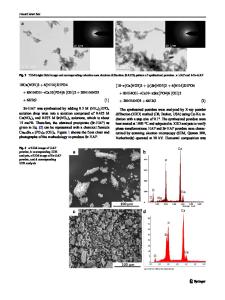Design, Synthesis, and Characterization of Hydroxyapatite Particulates
- PDF / 2,518,034 Bytes
- 6 Pages / 612 x 792 pts (letter) Page_size
- 77 Downloads / 360 Views
Design, Synthesis, and Characterization of Hydroxyapatite Particulates Chun-Wei Chen1, Kullaiah Byrappa1, Charles S. Oakes1, Wojciech Sushanek1, Richard E. Riman1, Mamoru Senna2, Kelly Brown3, Kevor S. TenHuisen3, and Victor F. Janas3 1 Department of Ceramic and Materials Engineering, Rutgers University, 607 Taylor Road, Piscataway NJ 08854; 2Faculty of Science and Technology, Keio University, 3-141 Hiyoshi, Yokohama 223, Japan; 3Johnson & Johnson Corporation Biomaterials Center, Rt. 22 W, P. O. Box 151, Somerville, NJ 08876 ABSTRACT New hydrothermal technology for the preparation of hydroxyapatite designer particulates has been developed. Phase diagrams were constructed for the pH dependent equilibrium between monetite and HA from 50 to 200oC. Thermodynamic calculations were completed using temperature dependent functions for the relevant solution phase and solid-liquid equilibria and solute species activity coefficients. Model accuracy was evaluated through experiment at 50, 100, and 200oC and pHs between 2.2 and 8.9. The thermodynamic calculations and experimental results are in good agreement. Stoichiometric, crystalline HA has also been prepared by heterogeneous reaction of Ca(OH)2 powder and aqueous (NH4)2HPO4 at room temperature using mechanochemicalhydrothermal methods. This method appears to have very good reproducibility in terms of crystallinity and chemical composition. INTRODUCTION Synthetic hydroxyapatite [HA, Ca10(PO4)6(OH)2] is a biocompatible material and consequently is widely used in biomedical applications such as implants and coatings onto prostheses [1-3]. The composition and properties of synthetic HA depend strongly on preparative conditions including the reaction pH, temperature, and precursor composition [4,5]. Expanded use of engineered materials incorporating HA may depend upon the ability to design HA particulates with well-controlled chemical and physical characteristics. Solution-based synthetic routes such as hydrothermal and mechanochemical-hydrothermal synthesis may provide a method to accomplish this. Conventional hydrothermal (C-H) synthesis is a method that can precipitate anhydrous multicomponent oxides typically at mild pressure (< 100 atm) and temperature (< 350 oC) using solutions, suspensions or gels as feedstock [6]. Mechanochemical powder synthesis is a solid-state synthesis method that takes advantage of the perturbation of surfacebonded species by pressure to enhance thermodynamic and kinetic reactions between solids [7]. Main advantages of the mechanochemical synthesis of ceramic powders are simplicity and low cost since conventional milling equipment can be used. The mechanochemical-hydrothermal (M-H) synthesis incorporates an aqueous phase into the system. Thus, the M-H technique can be envisioned as being located at the intersection of C-H and mechanochemical processing. A rational approach developing either of these two methods is as follows: (1) compute thermodynamic equilibria as a function of processing variables, (2) generate equilibrium diagrams to map the vari
Data Loading...











